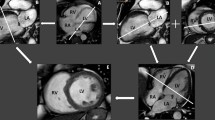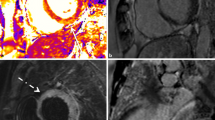Abstract
Cardiovascular CT and MRI are rapidly emerging technologies that can potentially change the current paradigm of cardiovascular imaging. Cardiac CT is primarily focused on imaging of coronary arteries for the assessment of vessel wall plaque and lumen stenosis. Additional information about ventricular and valvular function can also be obtained from the same three-dimensional image dataset. Cardiovascular magnetic resonance is a versatile imaging modality now considered a reference standard in the evaluation of ventricular morphology and function, with the potential to achieve a similar status in perfusion and viability assessment. This review summarizes key concepts regarding CT and MRI technology, clinical applications, and their role in clinical decision making. Recently published appropriateness criteria for cardiac CT and MRI by the American College of Cardiology are also reviewed.
Similar content being viewed by others
References and Recommended Reading
Of major importance Hendel RC, Kramer C, Patel MR, Poon M:ACCF/ACR/SCCT/SCMR/ASNC/NASCI/SCAI/SIR appropriateness criteria for cardiac computed tomography and cardiac magnetic resonance imaging.J Am Coll Cardiol 2006,48:1476–1497. The ACC, in collaboration with other key societies, assembled a panel of clinicians who evaluated 39 CCT and 33 CMR indications and developed appropriateness criteria for these new imaging modalities. Although not comprehensive, they are characteristic of contemporary practice and serve as a guideline for the practicing physician.
Of major importance Greenland P, Bonow RO, Brundage BH, et al.:ACCF/AHA 2007 clinical expert consensus document on coronary artery calcium scoring by computed tomography in global cardiovascular risk assessment and in evaluation of patients with chest pain: a report of the American College of Cardiology Foundation Clinical Expert Consensus Task Force (ACCF/AHA Writing Committee to Update the 2000 Expert Consensus Document on Electron Beam Computed Tomography).J Am Coll Cardiol 2007,49:378–402. Long-awaited consensus document by the ACC and American Heart Association on coronary calcium scoring. This document gives a comprehensive overview of the use of calcium scoring for diagnosis and prognosis of CAD.
Stary HC, Chandler AB, Dinsmore RE, et al.:A definition of advanced types of atherosclerotic lesions and a histological classification of atherosclerosis: a report from the Committee on Vascular Lesions of the Council on Arteriosclerosis, American Heart Association.Circulation 1995,92:1355–1374.
Budoff MJ, Georgiou D, Brody A, et al.:Ultrafast computed tomography as a diagnostic modality in the detection of coronary artery disease: a multicenter study.Circulation 1996,93:898–904.
Agatston AS, Janowitz WR, Hildner FJ, et al.:Quantification of coronary artery calcium using ultrafast computed tomography.J Am Coll Cardiol 1990,15:827–832.
Hecht HS, Budoff MJ, Berman DS, et al.:Coronary artery calcium scoring: clinical paradigms for cardiac risk assessment and treatment.Am Heart J 2006,151:1139–1146.
Pletcher MJ, Tice JA, Pignone M, Browner WS:Using the coronary artery calcium score to predict coronary heart disease events: a systematic review and meta-analysis.Arch Intern Med 2004,164:1285–1292.
Arad Y, Goodman KJ, Roth M, et al.:Coronary calcification, coronary disease risk factors, C-reactive protein, and atherosclerotic cardiovascular disease events: the St. Francis Hearth Study.J Am Coll Cardiol 2005,46:158–165.
Taylor AJ, Bindeman J, Feuerstein I, et al.:Coronary calcium independently predicts incident premature coronary heart disease over measured cardiovascular risk factors: mean three-year outcomes in the Prospective Army Coronary Calcium (PACC) project.J Am Coll Cardiol 2005,46:807–814.
Of importance Berman DS, Wong ND, Gransar H, et al.:Relationship between stress induced myocardial ischemia and atherosclerosis measured by coronary calcium tomography.J Am Coll Cardiol 2004,44:923–930. This paper examines the relationship between the presence of myocardial ischemia and severity of calcium scoring and provides the basis for rational use of stress perfusion imaging in patients with high calcium scores.
Scanlon PJ, Faxon DP, Audet AM, et al.:ACC/AHA guidelines for coronary angiography: a report of the American College of Cardiology/American Heart Association Task Force on Practice Guidelines (Committee on Coronary Angiography).J Am Coll Cardiol 1999,33:1756–1824.
Ropers D, Baum U, Pohle K, et al.:Detection of coronary artery stenosis with thin-slice multi-detector row spiral computed tomography and multiplanar reconstruction.Circulation 2003,107:664–666.
Mollet NR, Cademartiri F, Nieman K, et al.:Multislice spiral computed tomography coronary angiography in patients with stable angina pectoris.J Am Coll Cardiol 2004,43:2265–2270.
Achenbach S, Ropers D, Pohle FK, et al.:Detection of coronary artery stenosis using multi-detector CT with 16 x 0.75 collimation and 375 ms rotation.Eur Heart J 2005,26:1978–1986.
Hoffmann MHK, Shi H, Schmitz BL, et al.:Noninvasive coronary angiography with multislice computed tomography.JAMA 2005,293:2471–2478.
Of importance Garcia MJ, Lessick J, Hoffmann MHK, et al.:Accuracy of 16 row multidetector computed tomography for the assessment of coronary artery stenosis.JAMA 2006,296:403–411. First and only available multicenter trial for CCTA, which high-lights the clinical value and limitations of this new technology,
Of importance Raff GL, Gallagher MJ, O’Neill WW, Goldstein JA:Diagnostic accuracy of noninvasive coronary angiography using 64 slice spiral computed tomography.J Am Coll Cardiol 2005,46:552–557. One of the earliest reports evaluating the diagnostic value of the new state-of-the-art 64-slice technology. The investigators did not exclude patients based on their heart rate, obesity, or calcium score and analyzed the diagnostic value of CCTA using a more clinically relevant per-patient analysis.
Mollet NR, Cademartiri F, van Mieghem CAG, et al.:High Resolution spiral computed tomography coronary angiography in patients referred for diagnostic conventional coronary angiography.Circulation 2005,112:2222–2225.
Ehara M, Surmely JF, Kawai M, et al.:Diagnostic accuracy of 64 slice computed tomography for detecting angiographically significant coronary artery stenosis in an unselected consecutive patient population: comparison with conventional invasive angiography.Circ J 2006,70:564–571.
Ropers D, Rixe J, Anders K, et al.:Usefulness of multidetector row spiral computed tomography with 64×0.6 mm collimation and 330-ms rotation for the noninvasive detection of significant coronary artery disease.Am J Cardiol 2006,97:343–348.
Pugliese F, Mollet NRA, Runza G, et al.:Diagnostic accuracy of non-invasive 64-slice CT coronary angiography in patients with stable angina pectoris.Eur Radiol 2006,16:575–582.
Scheffel H, Alkadhi H, Plass A, et al.:Accuracy of dual source CT coronary angiography: first experience in a high pre-test probability population without heart rate control.Eur Radiol 2006,16:2739–2747.
Raff GL, Goldstein JA:Coronary angiography by computed tomography.J Am Coll Cardiol 2007,49:1830–1833.
Pache G, Saueressig U, Frydrychowicz, A, et al.:Initial experience with 64-slice cardiac CT: non-invasive visualization of coronary artery bypass grafts.Eur Heart J 2006,27:976–980.
Malagutti P, Nieman K, Meijboom WB, et al.:Use of 64-slice CT in symptomatic patients after coronary bypass surgery: evaluation of grafts and coronary arteries.Eur Heart J 2006 [Epub ahead of print].
Ropers D, Pohle FK, Kuettner A, et al.:Diagnostic accuracy of noninvasive coronary angiography in patients after bypass surgery using 64-slice spiral computed tomography with 330-ms gantry rotation.Circulation 2006,114:2334–2341.
Meijboom WB, Mollet NR, Van Meighem CAG, et al.:Pre-operative computed tomography coronary angiography to detect significant coronary artery disease in patients referred for cardiac valve surgery.J Am Coll Cardiol 2006,48:1658–1665.
Nagel E, Lehmkuhl HB, Bocksch W, et al.:Noninvasive diagnosis of ischemia-induced wall motion abnormalities with the use of high-dose dobutamine stress MRI: comparison with dobutamine stress echocardiography.Circulation 1999,99:763–770.
Hundley WG, Hamilton CA, Thomas MS, et al.:Utility of fast cine magnetic resonance imaging and display for the detection of myocardial ischemia in patients not well suited for second harmonic stress echocardiography.Circulation 1999,100:1697–1702.
Schwitter J, Nanz D, Kneifel S, et al.:Assessment of myocardial perfusion in coronary artery disease by magnetic resonance: a comparison with positron emission tomography and coronary angiography.Circulation 2001,103:2411–2416.
Lee DC, Simonetti OP, Harris KR, et al.:Magnetic resonance versus radionuclide pharmacological stress perfusion imaging for flow-limiting stenoses of varying severity.Circulation 2004,110:58–65.
Rieber J, Huber A, Erhard, I, et al.:Cardiac magnetic resonance perfusion imaging for the functional assessment of coronary artery disease: a comparison with coronary angiography and fractional flow reserve.Eur Heart J 2006,27:1465–1471.
Al-Saadi N, Nagel E, Gross M, et al.:Noninvasive detection of myocardial ischemia from perfusion reserve based on cardiovascular magnetic resonance.Circulation 2000,101:1379–1383.
Hundley WG, Morgan TM, Neagle CM, et al.:Magnetic resonance imaging determination of cardiac prognosis.Circulation 2002,106:2328–2333.
Ingkanisorn WP, Kwong RY, Bohme NS, et al.:Prognosis of negative adenosine stress magnetic resonance in patients presenting to an emergency department with chest pain.J Am Coll Cardiol 2006,47:1427–1432.
Of major importance Jahnke C, Nagel E, Gebker R, et al.:Prognostic value of cardiac magnetic resonance stress tests: adenosine stress perfusion and dobutamine stress wall motion imaging.Circulation 2007,115:1769–1776. Dobutamine and perfusion CMR have proven valuable in the diagnostic evaluation of CAD. This paper highlights the prognostic information provided by these tests in patients with known or suspected CAD.
Klein C, Nekolla SG, Bengel FM, et al.:Assessment of myocardial viability with contrast enhanced magnetic resonance imaging: comparison with positron emission tomography.Circulation 2002,105:162–167.
Ibrahim T, Bulow HP, Hackl T, et al.:Diagnostic value of contrast enhanced magnetic resonance imaging and single-photon emission computed tomography for detection of myocardial necrosis early after acute myocardial infarction.J Am Coll Cardiol 2007,49:208–216.
Kim RJ, Fieno DS, Parrish TB, et al.:Relationship of MRI delayed contrast enhancement to irreversible injury, infarct age, and contractile function.Circulation 1999,100:1992–2002.
Of importance Selvanayagam JB, Kardos A, Francis JM, et al.:Value of delayed-enhancement cardiovascular magnetic resonance imaging in predicting myocardial viability after surgical revascularization.Circulation 2004,110:1535–1541. One of few studies evaluating the use of CMR for viability testing prior to revascularization.
McCrohon JA, Moon JC, Prasad SK, et al.:Differentiation of heart failure related to dilated cardiomyopathy and coronary artery disease using gadolinium-enhanced cardiovascular magnetic resonance.Circulation 2003,108:54–59.
Mahrholdt H, Goedecke C, Wagner A, et al.:Cardiovascular magnetic resonance assessment of human myocarditis: a comparison to histology and molecular pathology.Circulation 2004,109:1250–1258.
Abdel-Aty H, Boye P, Zagrosek A, et al.:Diagnostic performance of cardiovascular magnetic resonance in patients with suspected acute myocarditis.J Am Coll Cardiol 2005,45:1815–1822.
Moon JC, McKenna WJ, McCrohon JA, et al.:Toward clinical risk assessment in hypertrophic cardiomyopathy with gadolinium cardiovascular magnetic resonance.J Am Coll Cardiol 2003,41:1561–1567.
Vignaux O, Dhote R, Duboc D, et al.:Clinical significance of myocardial magnetic resonance abnormalities in patients with sarcoidosis: a 1 year follow-up study.Chest 2002,122:1895–1901.
Maceira AM, Joshi J, Prasad SK, et al.:Cardiovascular magnetic resonance in cardiac amyloidosis.Circulation 2005,111:186–193.
Tanner MA, Galanello R, Dessi C, et al.:A randomized, placebo-controlled, double-blind trial of the effect of combined therapy with deferoxamine and deferiprone on myocardial iron in thalassemia major using cardiovascular magnetic resonance.Circulation 2007,115:1876–1884.
Cappendijk VC, Cleutjens KB, Kessels AG, et al.:Assessment of human atherosclerotic carotid plaque components with multisequence MR imaging: initial experience.Radiology 2005,234:487–492.
Didier D, Ratib O, Lerch R, Friedli B:Detection and quantification of valvular heart disease with dynamic cardiac MR imaging.Radiographics 2000,20:1279–1299.
Caruthers SD, Lin SJ, Brown P, et al.:Practical value of cardiac magnetic resonance imaging for clinical quantification of aortic valve stenosis: comparison with echocardiography.Circulation 2003,108:2236–2243.
Author information
Authors and Affiliations
Corresponding author
Rights and permissions
About this article
Cite this article
Beach, S., Syed, M.A. Current and upcoming roles of CT and MRI in clinical cardiac imagery. Curr Cardiol Rep 9, 420–427 (2007). https://doi.org/10.1007/BF02938370
Issue Date:
DOI: https://doi.org/10.1007/BF02938370




